

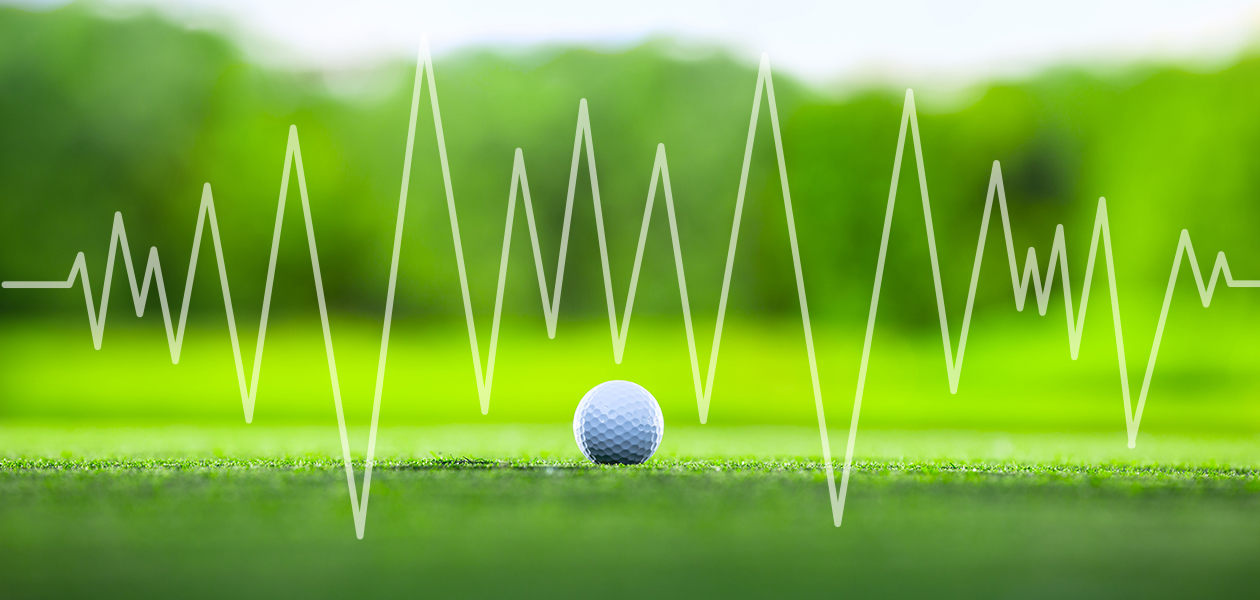
"Take the guess work out of course conditioning"
As a superintendent, you regularly hear comments such as ''greens are slow,'' ''fairways are soft,'' or ''the turf looks dry.'' Who’s right? Everyone has different expectations on how turf should look, and how a golf course should play. I’ve had the privilege to host 15 PGA Tour Canada events, and the last 10 consecutively. I’ve found that technology has made it much easier for staff to prepare our golf course, not only for tournament play, but for regular play as well. Most importantly, we have numbers and data that mean something to all those involved in course preparation and take the opinions out of the equation.
Working
with tour officials provides a grounds department the opportunity to
learn new techniques in course conditioning, and learn standards
needed for tournament preparation. Once the PGA Tour officials show up
and review the course, it’s “judgment day” for the grounds department. I
remember the first year we worked with the PGA Tour, the lead official
shook my hand, introduced himself, and asked “what’s your soil moisture
readings?” I thought, “wow he sure gets to the point quickly.” He later
told me that if the numbers are not to their standards, we need to get
busy.
Are PGA Tour conditions realistic? Well, yes, and no! I
would compare tournament preparation to an Olympic athlete that
dedicates their time and training for many years, to peak in a ten-day
period. Many of our cultural practices such as aeration and sand
topdressing, along with fertility programs, are set in place at the
beginning of the year, so the course will peak for a seven-day
period.
In 1984 when we hosted our first tour event and greens were rolling approximately 8' 5" on the stimp meter. We had the likes of Craig Stadler, Peter Oosterhuis, and Bob Tway in the field. We didn’t have greens rollers, and there was no way of measuring soil moisture and surface firmness.
Fast forward to our last event in 2017, we now have tools that can help staff make decisions based on data, rather than the look and feel of turf. We knew the grounds department was producing something special, when the officials had to extend yardage markings on fairways from 330 yards to 350 yards, on holes they measure driving distance. The fairways were playing fast. Was this luck and good weather? Or was this the result of a controlled agronomic plan? I will share with you some of the tools we’ve been using with the PGA Tour.
We collect data on green speed, surface firmness, and soil moisture. This starts one week in advance of the event. We take measurements every day, and during tournament week we take measurements twice per day. The information is submitted daily to the PGA Tour staff on site, and I send a complete summary to the PGA Tour at the end of our event.
Stimp Meter
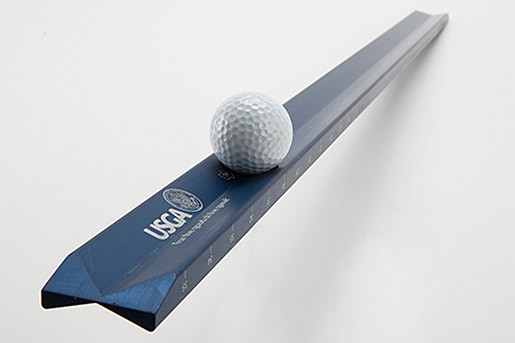 The first measurement is the stimp meter for green speed. Green speeds and consistency is key for all of us.
Tour
standards require speeds of approximately 10.5 to 11. Ideally, they
wanted us to increase speeds by 2” per day starting on the first day of
the tournament. Our green speed usually ends up around 12 feet by the
final day of the event.
The first measurement is the stimp meter for green speed. Green speeds and consistency is key for all of us.
Tour
standards require speeds of approximately 10.5 to 11. Ideally, they
wanted us to increase speeds by 2” per day starting on the first day of
the tournament. Our green speed usually ends up around 12 feet by the
final day of the event.
The chart is an examle of excel spreadsheet data that shows our green speed progress. On advance day six or “A6” we had 15 mm of rain and couldn’t take readings. Inside of two weeks we were able to increase green speeds by almost two feet.
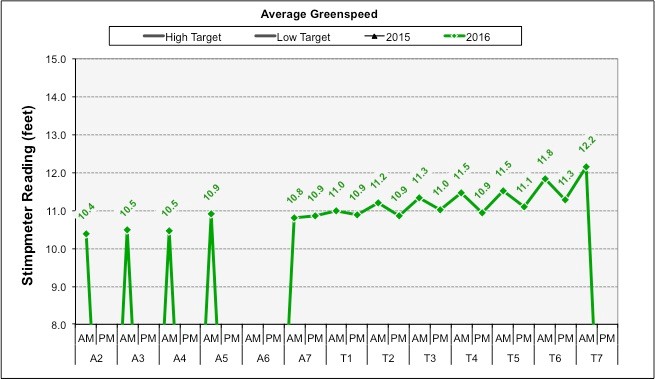
The chart tells us two things, the controlled increase of speed each day, and how much green speeds changed from the morning compared to evening readings. Green speed consistency is important to all golfers, not just golf professionals. We developed golf course maintenance standards, and our maintenance standards are between 9 -10 feet as requested by the golfers. We increase speeds slightly for tournaments. This has helped our round times stay at approximately 4 hours. Fast greens may be good for the ego, but fast greens slow down play with more three putts by golfers. One year we kept speeds at 12 feet for one week, and this slowed round times down by 35 minutes.
TruFirm Meter
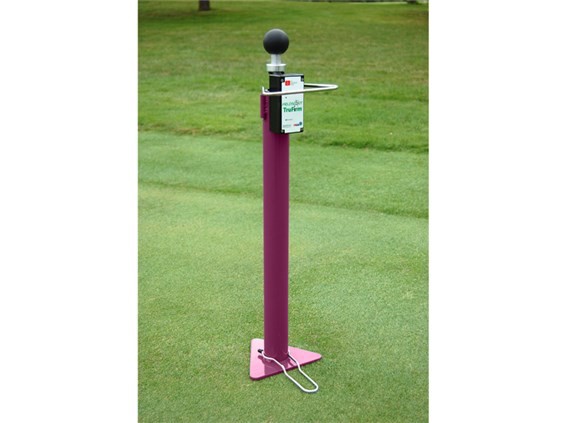 Our
second measurement is with a device called a TruFirm that measures
surface firmness. This unit measures the impact depth with a steel shaft
that is rounded at the bottom. The shaft is pulled up and released. The
depth of the impact into the green is measured to check firmness. We
take approximately 10 measurements on each green. If you get a reading
of 500, it means you create a depression of 1/2", if the reading is 250
the depth is ¼.”
Our
second measurement is with a device called a TruFirm that measures
surface firmness. This unit measures the impact depth with a steel shaft
that is rounded at the bottom. The shaft is pulled up and released. The
depth of the impact into the green is measured to check firmness. We
take approximately 10 measurements on each green. If you get a reading
of 500, it means you create a depression of 1/2", if the reading is 250
the depth is ¼.”
As
you can see, we were able to firm our greens to 243 or approximately
1/4" firmness on our greens. What does that mean? Well, the firmness of
plywood is 190, so our greens were very firm!

We use the TruFirm regularly to test firmness of greens as well as on our approaches. We’ve measured problematic approaches and developed specific plans to improve firmness by increasing sand topdressing, aeration, and sprinkler adjustments. As we know, some of our older golfers prefer the "bump and run" shot to the greens.
TDR Moisture Meter
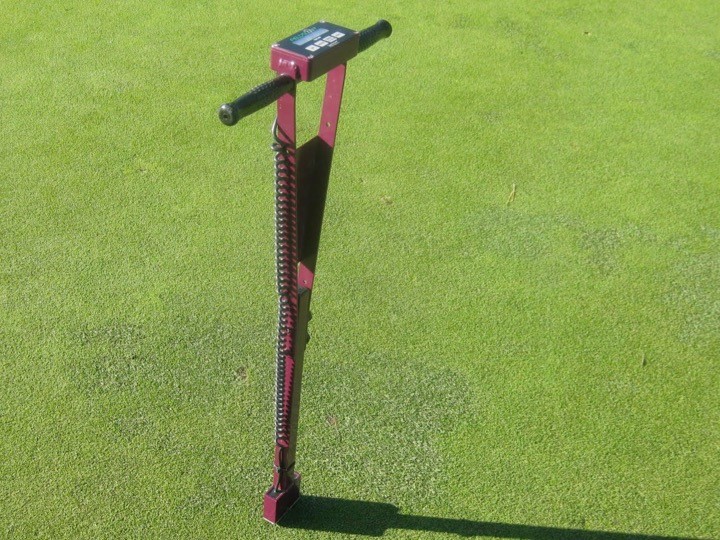 Our
first two measurements provide great information on the playability of
the course. The final measurement is soil moisture, which gives us the
plant health data we need to keep the plant alive, and aid in providing
the very best in playability. We use a TDR 300 moisture meter, and
measure soil moisture at a 3" depth. If we get soil moisture below 20%
during normal daily play, we will start to see temporary turf wilt.
During the tour event, we can take moisture levels lower, as tee
times start later and finish earlier. This allows staff to get back on
the greens, measure moisture, and apply the correct amount of water.
Our
first two measurements provide great information on the playability of
the course. The final measurement is soil moisture, which gives us the
plant health data we need to keep the plant alive, and aid in providing
the very best in playability. We use a TDR 300 moisture meter, and
measure soil moisture at a 3" depth. If we get soil moisture below 20%
during normal daily play, we will start to see temporary turf wilt.
During the tour event, we can take moisture levels lower, as tee
times start later and finish earlier. This allows staff to get back on
the greens, measure moisture, and apply the correct amount of water.
Compare this to regular membership play, where we normally can’t get back onto the course to hand-water until 24 hours later. I find managing soil moisture much easier to manage during a tour event because we actually have a much larger maintenance window.
As the moisture chart illustrates, we can see how daily temperatures affect moisture loss, and the impact of a rain event that we had on the advanced day 5.
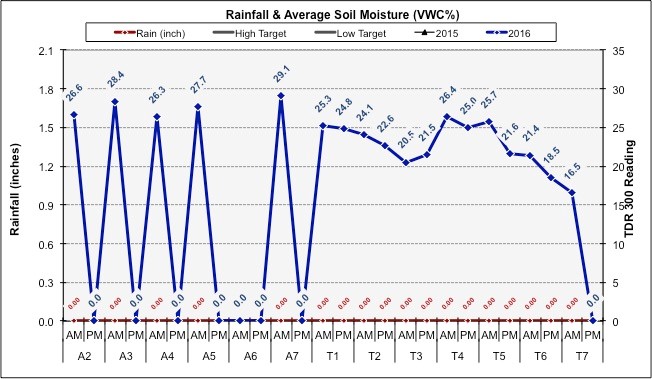
Technology continues to change in our industry, and the PGA Tour is quick to adopt the use of these tools. The combination of measuring stimp, moisture, and firmness, allows grounds staff to create consistent playing conditions without sacrificing plant health.
The officials showed up a week before our 2017 event and said, "the tournament could start today," because the conditions were already there. Moisture meters and firmness meters help golf courses measure and stay on top of current conditions. They can help monitor the progress of cultural programs such as sand topdressing, aeration and vertical mowing. How do you know if your practices are working if you can’t measure it? Well now we can. Don’t be afraid to try new technology, the numbers can give all the opinions at your course a number you can agree on.